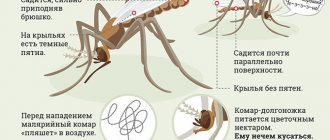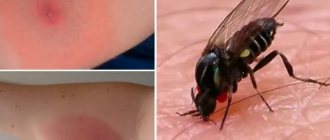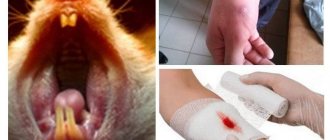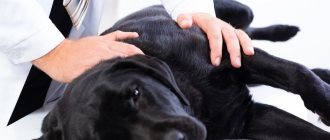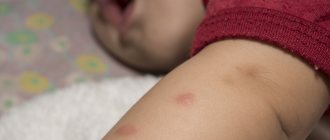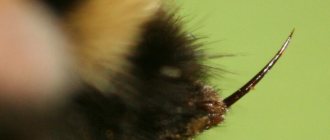Around 100,000 rat attacks on people are recorded annually around the world. Moreover, according to official statistics, only one rat bite out of 36 becomes known to health authorities and is included in these very statistics. That is, in fact, every year up to 3.5 million people around the world become victims of rat attacks, a significant part of which are children.
Perhaps the first thing to keep in mind is that if you or your child are bitten by a rat, there is no need to panic: it is not fatal, and the likelihood that a bite will cause infection with a dangerous disease, although possible, is very small. In addition, with the help of fairly simple actions, the risk of developing undesirable consequences after a rat bite can be minimized - we will talk about this in more detail below.
On a note
However, even without infection of the wound, a rat can cause serious injury with its sharp teeth. There are cases when these animals bit off a piece of a person’s ear and even broke a finger (crack in the bone). And in especially impressionable victims, a sudden rat attack can cause the development of phobias and various nervous disorders that can accompany a person for years, sometimes for the rest of his life. This is especially true for children.
So, let's see what needs to be done immediately if a rat bites, that is, literally in the first minutes after the rodent attack - the possible consequences of the bite largely depend on how correctly and quickly the appropriate actions are taken...
Briefly about rats
Anyone can become a victim of an attack. According to statistics, over 2,000 people die every year after being bitten by a rat, however, it is not the damage that is very dangerous, but the infection carried by rodents.
Animals can be roughly divided into wild and domestic. The former feel comfortable in urban environments and settle close to humans. If you are bitten by a wild or underground individual, trouble cannot be avoided, but domesticated relatives cause no less trouble. Of course, the bite of a miniature ornamental rat is not so dangerous in terms of infection. In exceptional cases, domestic animals carry diseases dangerous to humans. And they won’t bite without a reason. More likely for self-defense purposes or in case they want to play with them against their will.
How and how hard do rats bite?
There are situations when a person cannot say for sure whether he was bitten by a rat or some other animal. This happens when animals bite small children or pets. It is not difficult to distinguish damage from rat teeth.
These rodents have two rows of teeth - upper and lower incisors. Consequently, when bitten, two deep bleeding wounds form on the skin. The animals bite hard and can even injure an adult.
What to do if a child is bitten
If an animal attacks a small child, the algorithm for treating the wound is in all respects similar to that of an adult.
However, in this case, it is necessary to pay attention to the mental state of the victim. The child needs to be calmed and brought to his senses as soon as possible (cases of fainting are not uncommon even among adults), and try to prevent hysteria.
Otherwise, the child may develop a phobia about rats, which will affect his future life.
Why do rats bite?
A rat bites to protect itself or its offspring. She attacks people when they try to catch her. Utility workers are often attacked by rodents in basements. A person can provoke a rat if he waves his arms, a stick, or shows his fear by panicking.
In more rare cases, animals attack sleeping people, gnawing their heels. In impoverished areas of third world countries, rat attacks mainly target homeless people living in basements.
Before attacking, the rodent stands on its hind legs, swinging its body. At the same time, he tries to scare the person so that he can escape. The animal rushes at people from a distance, making a jump. Can bite, leaving deep wounds.
Wound healing and factors influencing this process
The wound healing process can be disrupted by many factors.
Healing is the process of repairing damaged tissue and restoring its integrity. During the healing process, certain processes occur. We will not dwell on them in more detail, but will only indicate those factors that may disrupt the healing process:
- Age. As a rule, this applies more to older people. The child's body has great regenerative capabilities. This is due to the high level of anabolic (construction) processes in the body.
- Attachment of infection.
- Decreased immunity.
- Poor circulation in the wound area.
- Chronic diseases (diseases of the respiratory and cardiovascular systems, diabetes, tumors and others).
Healing complications
- Attachment of infection . Most often, a nonspecific purulent infection develops. The threat is tetanus, rabies, diphtheria. Therefore, injuries that have been bitten and contaminated with soil or old metal objects should be immediately examined by a surgeon with a number of preventive measures taken (administration of anti-tetanus serum, rabies vaccine).
- Bleeding.
- Divergence of defect edges.
- In some cases, healing may be complicated by a hypertrophic scar or keloid . They are an abnormal scar that can spread beyond the defect area and also contribute to the development of complications.
What is known today about cannibal rats?
As noted above, there are quite well-known and frequent cases where rats gnaw off the hardened skin on a person’s heels. This usually happens when the victim is sleeping, and often the attack ends in serious trouble - the animals get to the soft tissues, and the wounds here do not heal for a very long time due to constant restlessness when walking.
When the rats realize that a person cannot harm them, they calmly gnaw off more and more pieces from his body. It was rats that killed a huge number of prisoners in prisons and captives in military camps in the Middle Ages: people were tied up, their ability to move was severely limited, and hungry rodents boldly (and competently) chewed on them, leaving bleeding wounds. A person usually died either from blood loss or from blood poisoning.
If a person is paralyzed or unconscious, they may suffer the same fate.
There is information about the terrible torture that guilty prisoners were subjected to in Stalin's labor camps: a person's hands and feet were tied, after which he was put in a large barrel, into which hungry rats were released. A few days later, corpses with their stomachs eaten away were taken out of the barrels. There were other options for torture...
And yet, we cannot talk about specialized cannibal rats. These animals are omnivores and eat any meat: whenever possible, the rat eats entrails and gnaws bones, and if it finds the corpse of any animal or person, it will bite off pieces of it too. The animal may not notice the difference between a corpse and an unconscious person.
That is, by and large, real cannibal rats are the most ordinary rats, eating everything, but by chance they simply found themselves next to the motionless body of a person and did not disdain to feast on it.
But rats that feed exclusively on human flesh are not known to science today. Moreover, there is no evidence that these animals can attack healthy people and bite them to death. Even an invasion of rats in certain areas never leads to human casualties. For example, from different Russian cities, rat infestations are reported with varying frequency, but no tragic cases follow these events.
How to protect yourself from attack
To protect yourself and your loved ones from rat bites, you need to monitor the sanitary condition of your living space. If a concentration of animals is found in another place, special services should be called to destroy pests and prevent attacks on people.
You also need to know the reasons for the attack. If an animal is scared, you should not show aggression towards it. You should leave this place and not disturb the rodent.
A rat may also attack if it is infected with rabies. In this case, when you see a wild animal, you must immediately leave and inform special services.
It is also forbidden to touch a mouse brought by a cat.
Your pet should be checked periodically by a veterinarian and up to date with required vaccinations.
It is not recommended to pet someone's rodent, as it may react aggressively to a stranger.
How to Avoid Bites
To avoid becoming a victim of a rat, first of all you need to avoid places where they live - landfills, basements of residential buildings, abandoned houses.
If you do happen to encounter a rat, under no circumstances should you panic, try to run away, or attack the animal (especially if you have a female in front of you, protecting her offspring).
Try to back away as slowly and carefully as possible to demonstrate to the rodent that you will not cause harm. Rats have a pronounced instinct of self-preservation.
Rats are harmful rodents that cause damage to furniture and people's food. They often settle near human habitation in order to easily obtain food for themselves.
As a result, there are frequent cases of rat attacks on humans. Under no circumstances should you provoke a rat to lunge, but if a bite occurs, be sure to provide first aid to the victim as soon as possible and take him to the emergency room. These actions are required if suspicious symptoms appear during the first few days - headache, nausea, weakness, chills, etc.
First actions after a rat bite
If you are bitten by a rat, do not panic. By adhering to a clear algorithm of actions, you can avoid harmful consequences.
- Rinse the wound under running water and then treat it with an antiseptic. Hydrogen peroxide, chlorhexidine, Miramistin, iodine or brilliant green are suitable for this. Don't wait for the bleeding to stop. The bites are usually deep and bleed for a long time.
- To avoid dirt getting into the wound and other mechanical damage, the affected area is bandaged.
- Observe the wound, and if you have the slightest doubt, consult a doctor.
It would be a good idea to get a preventive vaccination against rabies and other diseases, which will be offered at the nearest emergency room. Saliva is a breeding ground for bacteria and viruses.
What to do after being bitten by a pet rat
Pets are not considered carriers of diseases. However, if there is a wound, it is necessary to provide first aid to the victim and treat it thoroughly.
Change the bandages regularly and continue to treat the wound until it heals. If your health worsens, then this is a reason to contact a medical facility.
What to do if rats bite children in kindergarten
If a child, coming from kindergarten, complains that he was bitten by a rat, then not only therapeutic measures should be taken. Such a violation of the Sanitary Rules and Norms is an administrative offense.
Note! The teacher is obliged to monitor not only the children under his care, but also the order. Such a complaint requires contacting the Administration. If the problem is not resolved, then parents should write a complaint to the Sanitary and Epidemiological Service requesting an inspection. It is better to draw up a collective appeal, and attach to it copies of certificates from the health care facility where the doctor examined the injury.
Are bites from decorative rats and animals in pet stores dangerous?
If you are bitten by a pet rat or injured in a pet store, do not panic. Pets rarely show aggression. Most likely, they will not even bite through the skin. However, if the wound still bleeds, then it must be treated to avoid suppuration.
Also, pets and pet store animals are rarely carriers of dangerous infectious diseases.
What harm can they cause?
External damage to the skin is not the only damage caused by these animals. Sometimes rats bite off pieces of skin (such as an earlobe) or may even break a finger.
Most often they aim at the face or hands.
Cases have been recorded of a flock of hungry mammals gnawing the heels of sleeping people. This happens in the poorest urban areas with unsanitary conditions. However, the main danger that rat bites pose to humans is infection.
Diseases
Every year, up to 100,000 people are attacked by animals, according to official data. On average, 100 people a year die from a bite. However, the risk of developing the disease is reduced to zero with proper wound treatment.
Exceptions are dangerous infectious diseases that spread throughout the body when they enter the blood.
Sodok
The disease is treated in the early stages, after direct blood poisoning. A series of antibiotics are introduced into the body, and the wound is surgically cleaned. The risk of mortality due to untimely treatment (or lack thereof) is 10%.
Listeriosis
The disease is especially dangerous for people with weakened immune systems and pregnant women. The latter are at risk of fetal death and termination of pregnancy.
Coxiellosis
The consequences of bacterial coxiellosis are severe fever. The infection poses virtually no risk to life, but will bring a lot of painful inconvenience.
Rabies
A popular myth is that rats are active carriers of rabies. Actually this is not true. In the history of rat attacks, rabies has occurred only a few times. However, if you do not start timely therapy (currently it consists of five intermediate injections), there is a high risk of death.
Tetanus
A slightly more popular infection than rabies, but no less dangerous. Tetanus causes damage to the nervous system and internal organs, which often results in death. Every year, about 50,000 people die from tetanus. The victims are mainly teenagers and children.
Yersiniosis
Not the most dangerous infectious lesion. Accompanied by nausea and vomiting, fever, headache and abdominal pain. In healthy people, symptoms appear approximately 24 hours after the actual bite; in people with compromised immunity, symptoms appear almost a month later.
Toxoplasmosis
Like listeriosis, it is especially dangerous for pregnant women, as it threatens termination of pregnancy.
Cryptosporidiosis
The disease most often occurs in people with weakened immune systems. Its main symptoms are gastroenteritis and diarrhea, as well as weakness in the body.
Syphaciosis
Caused by the presence of helminths (worms) in the body of the rat. The likelihood that a person will become infected during a bite is practically zero - you can only get sick with syphaciosis if you directly ingest the helminth.
Melioidosis
Effective treatment of the disease is possible only with timely consultation with a doctor. Meliodia is accompanied by severe fever, increased temperature, headaches and joint pain.
Injuries
Not only infection can cause harm to the human body, especially if the rat bites until it bleeds. A bite cannot be avoided without minimal external damage, since the teeth of rats are very long and sharp - they can cause significant harm to the victim’s body even without blood infection.
Soft fabrics
In 90% of cases, rats bite through the skin, causing damage to soft tissue. Depending on the strength of the bite, the skin will recover faster or longer.
Abrasions and lacerations
If the victim is lucky and the mammal slips off him without having time to make a hole in the skin, the person will get off with an ordinary scratch - the risk of contracting even an infection from such a shallow cut is even less than in the case of a wound.
But if the rodent does tear the skin, due to the sharpness of the incisors and the body’s defensive reaction (the victim will try to shake his hand or tear off the animal), a deep laceration will form. Such damage will take a long time to heal, requiring serious care. They often leave behind scars.
Hematomas and bruises
If a person is lucky, he will escape with “a little blood” - such cases are the most common among victims of domestic rats. Weak incisors do not bite through the skin, leaving only external damage in the form of bruises and bruises. They pass quickly enough without leaving traces.
Fractures of the knuckles
In particularly severe cases, rats can damage bones and joints. If a rat bites your finger with the described consequences, you must contact a specialist to apply a plaster cast.
What to do if you are bitten by a wild rat
The greatest danger to humans comes from the bite of a wild animal. Let's figure out what to do if you are attacked by a wild rat.
You absolutely need to see a doctor, and before that, start treating the wound yourself as quickly as possible. Wash the affected area generously and thoroughly with a solution of laundry soap after the bleeding has stopped. To prepare the solution, take 1/3 of a bar of soap and dilute it in two glasses of water. After this, it is necessary to disinfect the wound with any antiseptic and apply a bandage. This way you will protect yourself from infection.
You can learn how to humanely kill a parasite in this article.
A wild rat, unlike a domestic rat, lives on the street, climbs into garbage cans and landfills, so the likelihood of infection is very high.
The most dangerous pests are for a sleeping person. After all, the likelihood of infection increases due to bites in the neck and face due to the peculiarities of the circulatory system in these places. The vessels here are located close to the skin, so the infection immediately enters the blood. In this case (as in others), it is also necessary to see a specialist.
Precautionary measures
The best safety measure when dealing with dangerous rodents is to avoid contact with the predators. Rats usually run away from people, but in a life-threatening situation they attack. To avoid putting anyone at risk of being bitten, consider the following:
- trash cans must always be closed;
- leftover food should not be left in the public domain;
- installation of special ultrasonic repellers and traps eliminates rodents;
- specialized services fight rats more effectively than residents alone;
- The correct behavior when meeting a predatory animal is to avoid sudden movements, attempts to photograph rats, catch them, hit them with a stick, etc.
The only measure that helps in a critical situation of a collision with an aggressive animal is to spray the animal with cold water. This way you can scare away an evil predator.
Lovers of rats as pets should remember that the desire to photograph the animal while simultaneously feeding from hands often leads to a rat bite. The photo is not worth it to heal the deep marks from the teeth of a predator.
Rats have coexisted with humans for centuries, causing hostile feelings in chance encounters. An intelligent, hardy animal in the fight for territory, food supply, and to protect its offspring is always ready to engage in battle with the enemy. Only knowledge of the characteristics of the animal will help to avoid painful injuries.
What to do if bitten by a rat (ambulance)
Differences between rat bites and bites of other animals
In some cases, it is not even clear who exactly bit the person - a rat, a mouse, or some other animal. For example, a bite can occur when a person is sleeping, or someone bites a child on the finger while he is playing in the house or on the street. It is even more difficult to identify the offender if the person who was bitten was a pet.
In general, it is not difficult to distinguish a rat bite from the bite of another animal. After a rodent attack, as a rule, two small bleeding wounds remain at the site of the bite - from the upper and lower incisors (sometimes such wounds are represented by two nearby skin lesions, since the rat has two well-developed upper and two lower incisors). This “pattern” is characteristic of rodent bites.
The photo below shows what a rat bite looks like on a person’s hand:
Perhaps the easiest way to confuse such a bite with the bites of other rat relatives: mice, voles, hamsters. The rat differs from them only in size (however, there is no need to make such a diagnosis, since all wild rodents are about as dangerous as rats).
Reasons for attacks on people
Most species of rats are extremely cautious creatures and try in every possible way to avoid meeting people. They decide to attack and bite in some situations:
- When the population is high and there is a shortage of food. Animals can bite a sleeping person or maul a small child to death. A patient who is bedridden, as well as a person who is heavily intoxicated, can die from the bites of large rodents.
- Rats are carriers of dangerous diseases and sometimes get sick from them themselves. A rodent can become infected with rabies. Rats are dangerous to humans because as the disease progresses, the animal stops reacting adequately to what is happening, loses fear, and becomes aggressive. Attacks other animals and humans.
- In a hopeless situation, driven into a corner, the rat takes a fighting pose. It stands on its hind legs, bares its teeth, and makes frightening sounds. Any movement of a person is regarded by her as dangerous to her life. The rodent jumps up with lightning speed and bites. He tries to grab the neck, but other organs may also be damaged.
Just like that, once in a person’s house, a rat will not attack or bite. But small children may be harmed because when the animal appears they will want to pet it.
First aid measures
If you are bitten by a rat, do not panic. A simple procedure must be followed to minimize the risk of blood poisoning. If a rat bites your finger, remove all rings from it so as not to impede blood circulation.
Washing
First of all, the wound must be washed with a soap solution and running water in a soap to water ratio of 1:4. You can't try to stop the bleeding right away.
Peroxide treatment
After washing, the damaged area must be treated with hydrogen peroxide or other antiseptics for disinfection (Furacilin, Chlorhexidine, etc.)
Iodine
Apply iodine or brilliant green to the wound, which will help disinfect the wound.
Applying a sterile dressing
To prevent external bacteria from entering the gap, it is necessary to apply a sterile bandage or bandage pre-treated with oxolinic ointment. If you don’t have one, you can limit yourself to just a sterile bandage.
Rodent control products
There are many repellent devices, and the operating principle is based on ultrasonic and electromagnetic waves. Such devices do not kill rodents, but force them to leave the room by affecting the nervous system. What types of repellers exist and what are the differences in operation:
- Electronic repellers. The essence of these devices is to distribute magnetic pulses through an electrical wire, which is a powerful irritant for rats and mice. The range of these repellers is enough to cover the entire area of the room.
- Ultrasonic repellers. These devices act on the nervous system of rodents with high-frequency sound vibrations with changing frequencies, due to which the rats do not have time to get used to the ultrasound and quickly flee.
- Combined repellers. These devices combine a dual effect on pests: high frequency sound and low range of electromagnetic waves. This variable component does not allow rodents to adapt.
The choice of a specific repellent device depends on a number of factors: the number of rats and mice, the area of residence, the level of human comfort, etc. Each device has a different radius of influence, so choosing a repeller for a specific case will not be difficult. Their undoubted advantage is that they quickly drive rodents out of the house.
Pain defect and sensitivity to rat bites
In fact, sensitivity to rat bites varies from person to person. But the fact that rats have very sharp teeth that grow throughout their lives makes rodent bites quite painful. Rats bite precisely with their incisors, which they sharpen by gnawing through wood. By burrowing into human skin, a rat can damage blood vessels, which can lead to bleeding. Due to the fact that there are many blood vessels located in the most commonly bitten areas (arms, legs and body), this makes a rat bite very dangerous. So you need to be very careful when catching rats. And if a rat does bite you, you need to take immediate action. We will talk about what to do if a rat bites you in the next paragraph.
If a rat bites your pet...
Adult pets usually do not require first aid after a rat bite. Cats and dogs will diligently lick the bite site themselves, and their saliva is not much less effective an antiseptic than iodine or brilliant green.
The wound of a kitten or puppy that does not yet know how to lick itself, but has already been weaned from its mother, needs to be seriously treated. In this case, the baby needs to be given the same first aid as a bitten person: wash the wound, treat it with an antiseptic and, if possible, bandage it. The same measures must be taken if a rat has bitten a cat or dog on the nose or ear - parts of the body that animals cannot fully lick (well, perhaps you can do without bandaging).
If your pet develops symptoms after being bitten, you should contact your veterinarian as soon as possible. In particular, sometimes the pet exhibits spasms of the spinal muscles, disturbances in gait, he cannot open his mouth and chew food normally - in such cases, a doctor should be called immediately. These are the symptoms that tetanus manifests itself, and when they appear, time is literally counted by the clock. You should not decide on your own what to do in such a situation, much less use medications at your own discretion.
Useful video: what to do if you are bitten by a rat (first aid)
Can rats give you rabies?
Rabies is a most dangerous infection for humans, transmitted from warm-blooded animals through bites and salivation of wounds. The greatest danger in terms of rabies infection are stray dogs or wild animals (for example, foxes), but there is no clear opinion regarding rats as a source of infection. In general, theoretically, like many other warm-blooded animals, rats are susceptible to the rabies virus, however, it is believed that they quickly die as a result of infection with it. Therefore, in practice, rabies has not been reported from bites by these animals. However, this does not mean that rat attacks and bites are completely safe - these rodents can infect a person with other quite dangerous ones. If not diagnosed in a timely manner, these diseases can have disastrous consequences, including death. Therefore, the condition of a person who has been attacked by rats and their bites is important to constantly monitor for several weeks.
What symptoms indicate infection?
There is a whole set of characteristic signs, upon the appearance of which a person bitten by a rat should be shown to a doctor as soon as possible.
The most common diseases that occur a few days (weeks) after rat bites are manifested by a typical fever with characteristic symptoms:
- Increased body temperature;
- Chills;
- Severe malaise and general weakness;
- Pain in the head;
- Digestive disorders, diarrhea, nausea, abdominal pain.
These are signs of most viral and bacterial fevers, leptospirosis and pseudotuberculosis. As a rule, they develop approximately a week or two after the bite, but sometimes the incubation period drags on up to a month, or, conversely, lasts only literally a few hours or a day. This, by the way, is one of the difficulties of diagnosis - often by the time symptoms appear, a person has already forgotten that he was bitten by a rat.
Here, for example, are the characteristic signs of tetanus:
- Acute pain at the site of the bite, even if the bite itself has long since healed (several weeks after the rat attack);
- Muscle twitching at the site of the bite;
- Tension of the chewing muscles, sometimes not allowing you to open your mouth at all;
- Insomnia;
- Excruciating back pain.
With sodoku, in addition to pain, an infiltrate with constantly leaking fluid may develop at the site of the wound. With a nonspecific local infection, a painful inflammation first appears here, and then a characteristic abscess.
It is also useful to read: Black rats: photographs and interesting facts about the life of these rodents
In general, there is no need to remember these symptoms. Any disturbance in the general health of the victim in the weeks following the rat attack is likely to be related to the bite itself. Moreover, the first “bell” can be not only a generalized sign, but also local manifestations - pain, itching, spontaneous muscle contractions near the wound, even if it has healed. None of them should be ignored, and if symptoms are obvious, you should see a doctor as soon as possible.

